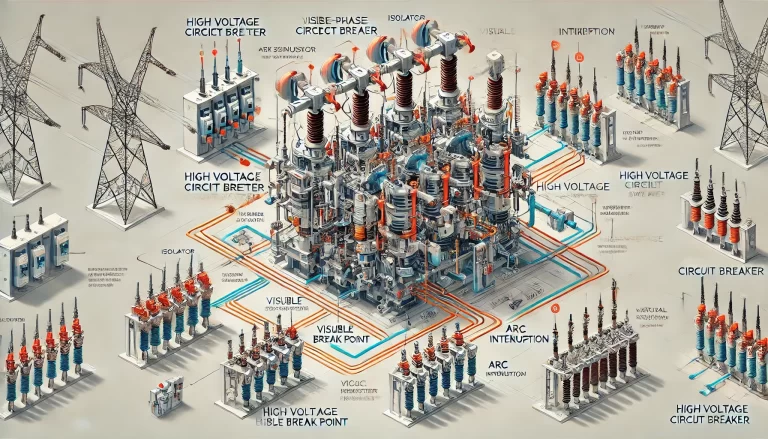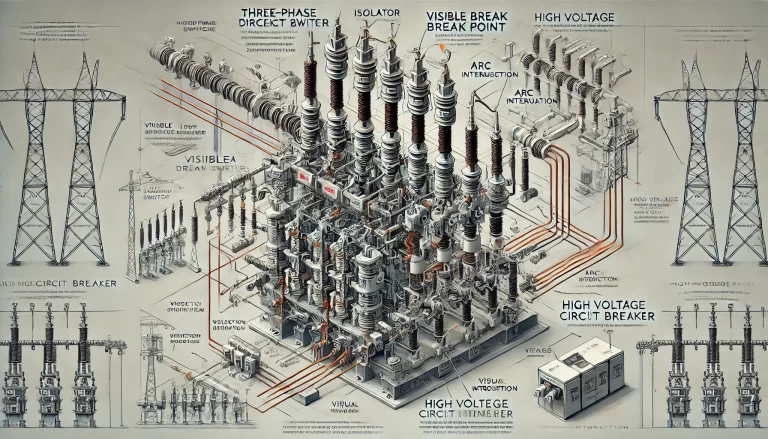In high-voltage power systems, circuit breakers and disconnect switches are two critical components used for electrical control and isolation. Although they are often used together in substations, they serve very different purposes in terms of function, structure, and safety.
1. High Voltage Circuit Breaker
A high voltage circuit breaker (HV CB) is a key device used in substations to control, protect, and isolate electrical power equipment.
Key Features:
Arc Interruption: Equipped with an arc extinguishing mechanism, allowing it to break load current and interrupt fault current during short circuits or overloads.
Protection Role: Works in conjunction with current transformers (CTs) and protective relays to perform short-circuit protection, overload protection, and earth leakage protection.
Operational Flexibility: Can safely open and close circuits under normal or fault conditions.
Complex Design: Contains mechanical and electrical components designed to withstand high fault currents and dynamic switching operations.

2. High Voltage Disconnect Switch
A high voltage disconnect switch (isolator) is primarily used to visibly isolate a portion of the circuit during maintenance or inspection.
Key Features:
No Arc Quenching: It lacks an arc-extinguishing mechanism and should not be used to interrupt current, except in special cases under <5A light load.
Visible Break Point: The open/closed status is visually obvious, making it easy to confirm safe disconnection during servicing.
Mechanical Isolation Only: It does not provide electrical protection or coordination with relays.
Simple Structure: Typically consists of blades, insulators, and operating mechanisms without complex interlocking systems.
3. Common Terminology
Circuit Breaker: Often referred to simply as a “switch” in operation.
Disconnect Switch: Commonly known as a “knife switch” or “isolator” in field use.
These two devices are often used in combination, where the circuit breaker handles load/fault operations and the disconnect switch provides clear isolation.

4. Comparison Table: HV Circuit Breaker vs. Disconnect Switch
| Feature | High Voltage Circuit Breaker | High Voltage Disconnect Switch |
|---|---|---|
| Function | Load and fault current breaking | Circuit isolation only |
| Arc Extinguishing | Yes (built-in arc chamber) | No |
| Load Switching | Yes | No (except light load <5A) |
| Protection Capabilities | Yes (CT + relay integration) | No |
| Structure | Complex, sealed | Simple, open-frame |
| Visible Disconnection Point | Not always (some types have it) | Yes |
| Can Provide Isolation? | Sometimes (few models) | Always |
| Usage Name | Switch / Breaker | Isolator / Knife Switch |
5. Special Note: Load Break Switches
In some discussions, a Load Break Switch (LBS) may also be mentioned. It is:
Capable of interrupting load current.
Has limited arc-quenching capacity, much smaller than circuit breakers.
Often protected with fuses, providing basic short-circuit protection.
Structurally simpler than a breaker but more complex than an isolator.

Conclusion
High-voltage circuit breakers and disconnect switches each play distinct roles in the safe and efficient operation of electrical power systems. While circuit breakers are designed for dynamic, protective switching operations, disconnect switches are simple devices used mainly for visible isolation. Understanding their differences ensures proper equipment selection, maintenance planning, and system safety.
